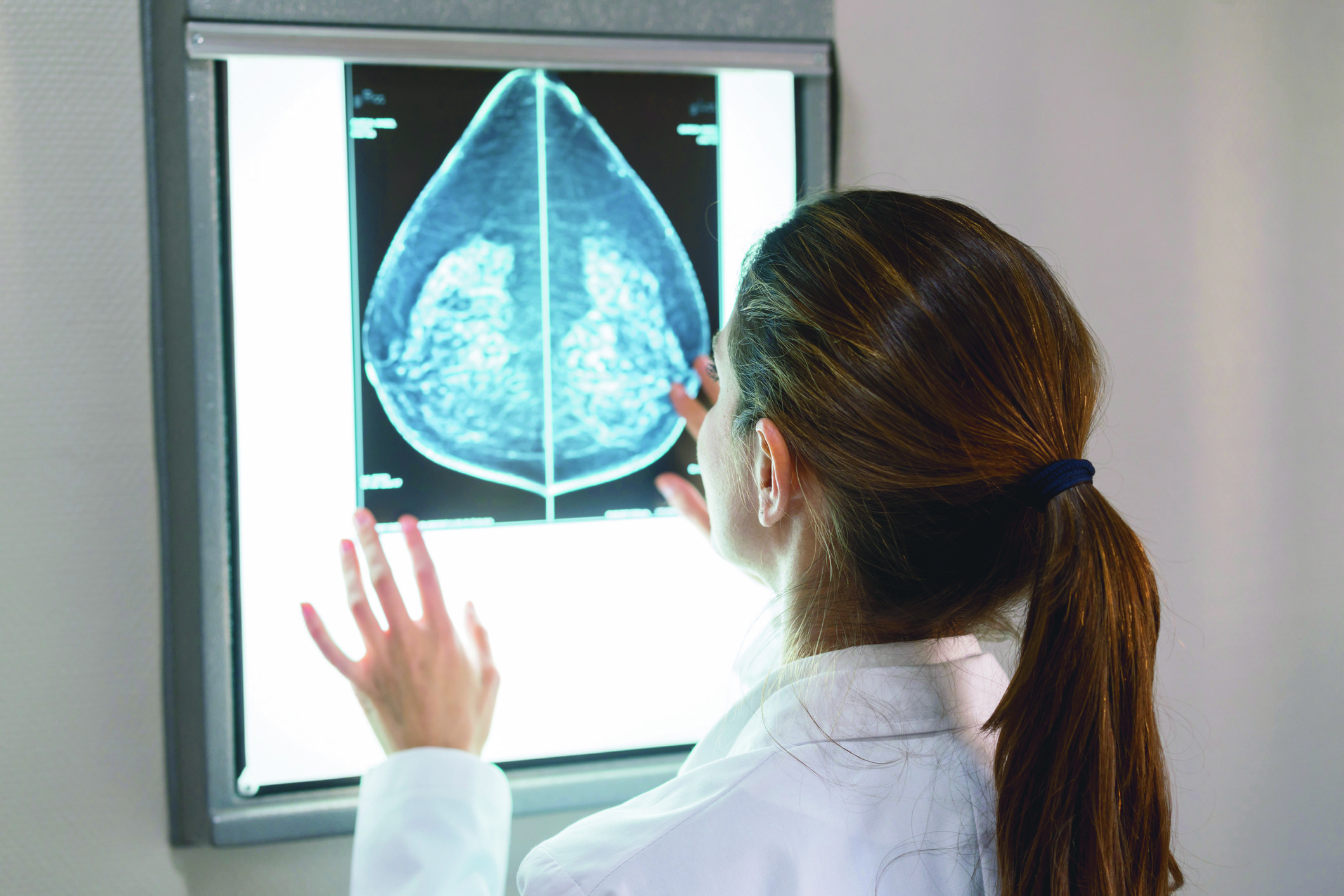Is surgery now a redundant procedure for certain subgroups?
- Breast cancer is the most commonly diagnosed cancer (excluding skin cancer) and the leading cause of cancer mortality in females, accounting for one-third of cancer cases diagnosed in Irish females between 2015-2017.
- The management of breast cancer has changed significantly over time due to the remarkable improvement in our disease knowledge and the unprecedented progress in science.
- I will highlight some of these significant changes in this article.
Breast cancer was described for the first time as a bulging tumour by an Egyptian surgeon in 460 BC and he believed that there was no curative treatment for this tumour, while Hippocrates thought breast cancer developed due to excess bile and surgery had a deleterious effect, and he named it ‘karkinos’, which means crab in Greek. Dr William Halsted, a pioneer surgeon, proposed that breast cancer spread in a stepwise fashion from the breast to pectoralis muscles then to lymph nodes which work as a barrier for distant metastasis.
In 1882 he documented his radical mastectomy in which he removed the breast, pectoralis muscles, and the entire axillary nodes and achieved 97 per cent local and 80 per cent locoregional control within three years. Up to 1970 it was performed in 90 per cent of breast cancer patients in the US, however, the morbidity was high despite low perioperative mortality.
In contrast to Halsted, Dr Bernard Fisher thought breast cancer was primarily a systemic disease and less surgery (eg, lumpectomy) might be appropriate and he preserved the pectoralis muscles and achieved comparable survival, while Dr David Patey preserved the pectoralis major muscle and his technique was less morbid compared to that of Halsted’s.
After the advent of widespread availability of radiotherapy and in an attempt to reduce surgical morbidity, the Surgical Adjuvant Breast and Bowel Project (NSABP) initiated the B-04 trial in 1971, which randomised 1,700 breast cancer patients with negative axillary nodes into three groups; Halsted radical mastectomy, simple mastectomy with locoregional irradiation, and simple mastectomy without irradiation. After a median follow-up of 14 years there was no difference in local treatment failure, distant metastasis or survival and this established the emerging role of simple mastectomy.
This approach encouraged the NSABP to conduct another trial in 1976 (NSABP B-06), which randomised 2000 women to total mastectomy, lumpectomy alone, or lumpectomy followed by breast irradiation. All had axillary dissection and after more than nine years of follow-up, ipsilateral breast cancer recurrence was 43 per cent and 12 per cent for lumpectomy without radiotherapy and for lumpectomy with radiotherapy, respectively, without any significant difference in distant disease-free survival (DFS) or overall survival among the three groups. The same benefit for lumpectomy and radiotherapy still stands after 20 years follow-up and the equivalence of mastectomy to breast conserving therapy (BCT) was confirmed in a meta-analysis.
Breast cancer was hypothesised to be a systemic disease with circulating tumour cells in the blood and the cytotoxic effect of chemotherapeutic drugs on these cells led to the development of adjuvant chemotherapy after surgery. In 1971 the NSABP study using L phenylalanine mustard after radical mastectomy for patients with positive axillary nodes confirmed better DFS for the adjuvant group and Bonadonna et al, in a study for adjuvant CMF chemotherapy after radical mastectomy in primary breast cancer with positive axillary lymph nodes, showed that treatment failure occurred in 24 per cent of the control group and in 5.3 per cent of the adjuvant group after 27 months follow-up.
During this era, conservative breast surgery with radiotherapy and adjuvant chemotherapy was considered the standard treatment for most breast cancer patients. Recently, as an attempt to reduce the morbidity from axillary dissection, the ACOSOG Z0011 phase 3 trial (1999-2003) randomised female patients with clinical T1 or T2 invasive breast cancer, no palpable axillary adenopathy, and one or two positive sentinel lymph nodes. All patients had planned lumpectomy, tangential whole-breast irradiation and adjuvant systemic therapy and those patients were randomised into axillary dissection versus no dissection and after 10 years follow-up the regional recurrence did not differ significantly between the two groups.
The result was echoed in principle by the AMAROS trial, which randomised patients with T1-2 primary breast cancer and clinically negative axillary nodes into either axillary lymph node dissection or axillary radiotherapy in cases where a positive sentinel node was identified and after a median follow-up of six years the axillary control was comparable with significantly less morbidity in the radiotherapy group. Nowadays sentinel lymph node mapping is considered the standard approach and axillary dissection is preserved for cases with high burden of nodal disease.
Neoadjuvant chemotherapy (NAC)
Neoadjuvant therapy refers to the administration of systemic treatment prior to definitive surgical treatment with the aim of downstaging the tumour. This may allow less extensive surgery of the breast and/or ipsilateral axilla, possibly permitting the avoidance of mastectomy. It would also allow in vivo evaluation of the effectiveness of a selected systemic therapy, which may be a strong prognosticator for the risk of relapse.
The remarkable improvement in the treatment outcome of some cancers like head and neck, oesophageal cancer, osteosarcoma and even locally advanced breast cancer with the use of neoadjuvant systemic treatment encouraged the NSABP to randomise 1,523 women with operable breast cancer to four cycles of AC chemotherapy followed by surgery versus surgery followed by four cycles of AC chemotherapy. Although the overall survival was equivalent, the rate of breast conservative surgery (BCS) was higher in the neoadjuvant treatment arm.
As of today, neoadjuvant systemic treatment (NST) is used in 17-40 per cent of early breast cancer patients depending on their biological subtype. Pathologic complete response (pCR) is achieved in 20 per cent of all patients after NST. The achievement of pCR depends mainly on breast cancer subtype and stage and it is achieved in approximately 40 per cent of HER2-positive cases, 23 per cent of triple-negative tumours and 0.5 per cent of luminal A tumours.
However, recent studies for dual HER2 blockade for HER2-positive tumours and carboplatin-based chemotherapy regimes in triple-negative tumours have revealed pCR rates up to 68 per cent and 80 per cent. This illustrates that pCR rates after NST might increase even further in the years ahead. Nowadays the role of NAC is well-established and is the major player in trials of non-surgical treatment of breast cancer.
Radiotherapy: More is not always better
Post-mastectomy radiotherapy has improved DFS and overall survival based on many large randomised trials. Meta-analysis of 22 randomised trials has confirmed the benefit for patients with four or more positive axillary nodes while the Danish trial proved efficacy in T3 or more regardless of number of involved nodes. Many randomised trials have shown that BCS plus radiation is at least equivalent to mastectomy and many studies reported lower recurrence and better survival for BCT and radiotherapy when compared with BCS alone.
The standard radiotherapy regimen in those trials was a five-week course and in an attempt to reduce the number of radiotherapy sessions, a Royal Marsden trial compared 50Gy/25 fractions versus 39Gy/13 fractions versus 42.2Gy/13 fractions, which confirmed better local control with 42.2Gy, and the equivalence of hypofractionation to conventional fraction for both BCS and mastectomy has been confirmed in many trials. One step further to reduce the radiotherapy fractions was examined by the recent FAST-Forward trial, which compared one week of radiotherapy (27Gy or 26Gy)
versus the standard three weeks in patients with pT1-3N0-1. After five years follow-up the shorter regimen was non-inferior to the standard regimen in terms of control and cosmesis.
Biology-driven radiotherapy has been tested in two trials for elderly patients (70 years in CALGB and 65 years in Prime 11 trials). In those trials omission of radiotherapy after BCS was permitted for patients with T1-2N0 cases with favourable biology(ER/PR+ and Her-2 negative). Five-year local recurrence was 4.1 per cent and 1.3 per cent for radiotherapy and no radiotherapy, respectively, without compromising survival and this practice is considered a valid option in elderly patients.
Treating smaller volumes with radiotherapy is associated with less morbidity and to test this concept without compromising efficacy, accelerated partial breast irradiation (APBI) was developed. APBI is delivered only to the breast tissue immediately adjacent to the initial tumour site, typically a 1-2cm margin of breast tissue surrounding the surgical cavity. The rationale for this approach is based on the fact that most recurrences occur near the initial tumour location.
Many trials using different techniques whether 3D conformal, brachytherapy or intensity-modulated radiotherapy (IMRT) have shown non-inferiority when compared with whole breast radiotherapy in properly selected low-risk patients.
Non-surgical treatment
The initial trials for non-surgical treatment of breast cancer considered radiotherapy alone or chemoradiotherapy for patients who refused or were unfit for surgery. The excellent responses achieved using NAC have expanded those attempts.
Radiotherapy trials
The role of adjuvant radiotherapy in the management of breast cancer is well established. However, its role as a definitive treatment using conventional fractionation is still evolving. There are no prospective comparative studies in the literature of the current standards (surgery +/− radiotherapy +/− chemotherapy/hormonal therapy) versus definitive radiotherapy. The role of definitive radiotherapy in breast cancer came about initially from reports of small case series in patients who refused or were unfit for surgery and more recently from better understanding of the radiobiology as well as the availability of radiotherapy machines, which can deliver higher doses more precisely.
Sousa et al reported 18 per cent complete response in 76 patients with locally advanced breast cancer after neoadjuvant radiotherapy, and Chargari et al achieved a seven-year local control rate of 95.8 per cent in a group of elderly patients with early breast cancer treated with radiotherapy alone. In contradiction with these good results, Zucali et al reported poor local control (50 per cent) in 94 patients with early breast cancer treated with definitive radiotherapy, but this was explained by low radiotherapy dose and delivery of treatment over a long treatment period. This explanation was confirmed by Arriagada et al, and echoed by Van Limbergen et al, who reported that in order to achieve the same local control achieved with surgery, radiotherapy dose should be 10Gy higher for T1 and 35Gy higher for T2.
The role of definitive radiotherapy in the management of breast cancer has been revisited as a result of better understanding of breast radiobiology and the development of modern radiation techniques like stereotactic irradiation and IMRT, which deliver tumoricidal doses without severe complications. Many sites including lung, brain, spine, and prostate have adopted stereotactic ablative body radiosurgery (SABR) as a definitive treatment option in early-stage disease. SABR has many advantages with the delivery of high doses of radiation over a short period saving treatment days and overall time on the treatment machine.
In a phase 1 study by Bondiau et al for NAC given concurrently with SBRT prior to surgery, the pCR was 36 per cent, while Shibamoto et al reported 93 per cent and 92 per cent three-year overall survival and local control rates, respectively, with good cosmesis in 18 patients treated with definitive whole breast radiotherapy with stereotactic boost.
Concurrent chemoradiotherapy
Primary concurrent chemoradiotherapy (CCRT) is the first choice in treating nasopharyngeal, locally advanced cervical and anal cancers. The rationale of using CCRT is based on the radiosensitising effect of some cytotoxic drugs and the possibility of using lower radiotherapy doses to minimise the side-effects. Several phase 3 studies exploring the effect of CCRT in early breast cancers have reported good local control, but increased cardiac and pulmonary toxicities.
However, a Japanese study for CCRT in 108 breast cancer patients with stage I-III disease reported 36 per cent pCR, and this was confirmed in a small series of five patients with breast cancer who refused surgery and were treated with concurrent chemotherapy and an advanced radiotherapy technique called tomotherapy, where only one patient had local recurrence.
Neoadjuvant chemotherapy and local treatment
In a group of patients who achieved complete remission after NAC, five-year locoregional recurrence was similar between patients who had radiotherapy alone and those who had wide local excision and radiotherapy. The five-year overall survival rates were similar for both surgery and RT (74 per cent post-RT vs 76 per cent post-surgery, P=0.9) after NAC in a study by Ring et al, while Daveau et al reported higher local recurrence for the non-surgical group; 31 per cent versus 17 per cent at 10 years with no difference in overall survival.
Many randomised trials have shown that BCS plus radiation is at least equivalent to mastectomy and many studies reported lower recurrence and better survival for BCT and radiotherapy when compared with BCS alone
Is surgery a redundant procedure for certain subgroups?
There is a notable improvement in pCR with the use of modern chemotherapy regimens and targeted therapy and this raises the question of the safe omission of surgery specially if radiotherapy will be administered. However, there are two challenging problems in neoadjuvant trials; the first one is the definition of pCR and the second is the accurate diagnosis of residual disease.
So far there is no universal definition of pCR which complicates interpretation of NAC trials. Some consider absence of residual disease in both the breast and axilla as pCR, while others do not count on disease status in the axilla, some consider absence of both invasive and carcinoma in situ, while others do not take the in situ component into their account. The most accepted definition of pCR is either absence of any residual invasive cancer or any invasive and non-invasive cancer in both breast and axillary nodes.
Assessment of response after NAC
This assessment is crucial for further management and delineation of surgery. However, it might be difficult, particularly if there is significant reduction in tumour cellularity. The most commonly used methods to assess the response include clinical examination, breast ultrasound, mammogram, MRI breast, PET scan, and clip insertion into the tumour.
For better evaluation of pCR, especially if surgery will not be carried out, some investigators recommended elastography, which can discriminate stiffness in different tissues, addition of Ki-67, use of doppler ultrasound to measure tissue perfusion, dynamic contrast MRI and the use of core biopsy. However, the current imaging modalities are not accurate enough to confidently make this decision. Schaefgen et al and Lobbes et al reported a negative predictive value of pCR based on radiology of less than 90 per cent and they cannot replace the operative pathology.
Minimally invasive image-guided biopsy has shown promise in the identification of residual disease in the breast after NST and the positive predictive value for pCR was shown to be significantly high for vacuum-assisted core biopsy (VACB) and might reach 100 per cent, which makes it a very reasonable approach to assess pCR.
However, the accuracy of imaging and minimally invasive image-guided biopsy is still facing a great challenge because of the different patterns of tumour response as the tumour might shrink early in the course of treatment leaving few cells to trace or there might be diffuse cell loss without significant change in the tumour size.
A combination of advanced radiologic imaging, VACB and deep learning might minimise the possibility of missing any residual disease, although the impact of residual disease on local recurrence is still controversial, especially if radiotherapy will be used after NAC. Some investigators have reported more relapse, while others denied any significant consequences based on extrapolation of data from rectal and oesophageal cancer where a watch policy is an accepted option after complete response following CCRT.
In conclusion, to answer the question of safe omission of surgery after pCR post NAC we should design a trial comparing two strategies after NST: (i) standard therapy being surgery plus radiation treatment, (ii) no breast surgery, but standard radiation treatment.
MD Anderson Cancer Centre in the US recently opened and has begun accrual on the trial ‘Identification of breast cancer patients for potential avoidance of surgery: Accuracy of image-guided percutaneous sampling compared with surgery to evaluate eradication of breast cancer after preoperative chemotherapy’ (Clinicaltrials.gov NCT02455791). The study is designed to evaluate whether patients with residual carcinoma can be accurately identified using state of the art image-guided fine needle aspiration and VACB.
The Netherlands Cancer Institute as well as other national and international single-centre and multicentre and cooperative groups are developing similar trials.
References on request













Leave a Reply
You must be logged in to post a comment.